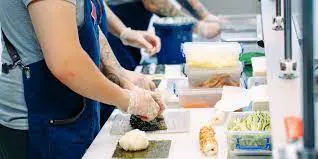It’s fast approaching midnight, and you’ve never felt hungrier. With limited dining options available so late, you look to your phone for a place that delivers. A restaurant with great reviews pops up. You look at the menu, place your order, receive your food, and get to grubbing.
The meal is one of the best you’ve eaten in years. It’s so good you decide to take your friend there next Friday. You Google directions and drive into an industrial complex far from any main street or neighborhood. The address is correct, but there’s no sign of a restaurant anywhere.
After ten minutes of poking around, you spot a car pull up, and someone gets out with a delivery bag. They enter an unmarked building and leave minutes later with a hot bag full of food. What gives?
You just discovered a dark kitchen, and there are more of them out there than most people realize.
What’s a dark kitchen?
Also known as a virtual restaurant or cloud kitchen, a dark kitchen is essentially a restaurant without dine-in or carryout service. It’s delivery only, and that’s because it’s nothing more than a kitchen and enough space to store supplies.
When more people want food delivered to them than ever before, the concept of a dark kitchen is gaining traction. Without all the overhead of a traditional restaurant, someone running a dark kitchen can make a significantly greater profit in a shorter amount of time.
If running a dark kitchen sounds like an enticing idea, the next step is figuring out what it takes to get started. The following is a basic breakdown of what sort of investments and expenses you’ll have to make to open a dark kitchen:
Kitchen Space
Like with any foodservice operation, you’ll need a kitchen for making your product. Most dark kitchens work out of warehouses, industrial complexes, and other unconventional areas. That’s because these areas tend to have commercial space for rent at affordable prices. As far as the amount of space goes, you’ll probably want a kitchen that’s 800 to 1000 square feet in size.
Equipment
Ovens, grills, sinks, countertops, cookware, and utensils will take up the bulk of your startup capital. As far as the bulky machines and equipment are concerned, it’s probably best to stick with preowned options to save money. However, when it comes to the pots and pans and utensils, you’ll want to spare no expense. Avoid ceramic cookware since the oils released during the cooking process can leech into the foods and alter the flavor. Stainless steel cutlery and blue steel cookware are the most popular choices, but the ultimate decision should be based on the types of foods being prepared.
Licensing
Most municipalities require foodservice businesses to obtain proper licensure. You’ll also need to ensure everyone handling food has gotten vaccinated against hepatitis C as well as the COVID-19 virus. Dark kitchens that fail to clear health and safety hurdles through adequate regulatory means will be shut down within weeks, so don’t start taking orders until this step is complete.
Marketing
Word-of-mouth advertising is hard enough for a restaurant with an unmistakable presence, so it certainly won’t cut the mustard for dark kitchen marketing. This is where the smoke and mirrors come into play (within reason); the marketing must present your operation as if it were a legitimate restaurant like any other, but absent any intentionally misleading information. For instance, photographs of food on plates is okay, even though there’s no dining. However, you don’t want to use stock images of people seated inside a restaurant since that implies dine-in is possible when it’s not.
Payroll
Like most businesses, payroll will most likely be your most significant expense. Luckily, the size and scope of a dark kitchen mean you won’t need more than a handful of employees on the clock at any given time.
Delivery
While you could have an in-house fleet of delivery drivers, most dark kitchens opt to work with third-party services like Uber Eats and Grubhub. While these and other delivery services charge something along the lines of 25% of every order they handle, that’s still a better deal than paying delivery staff yourself.
Now you know what a dark kitchen is, and even better, how to start one up on your own. Good luck!

















